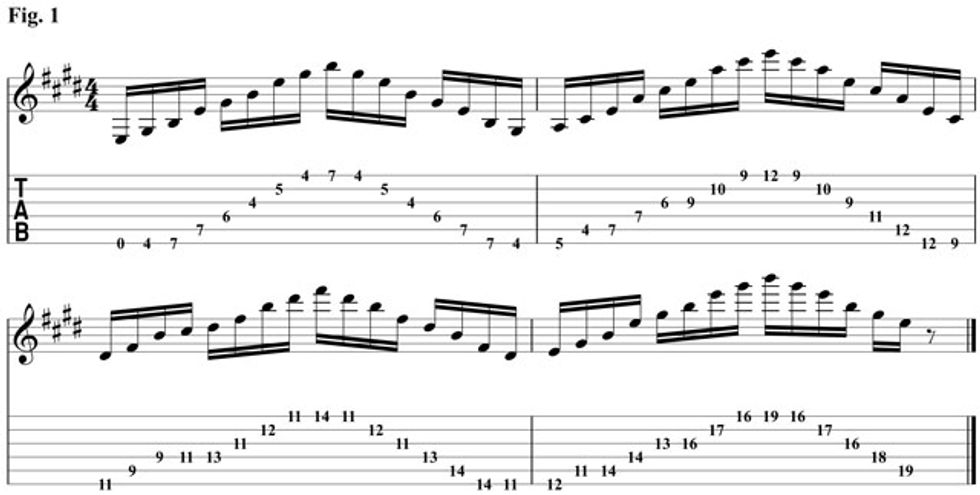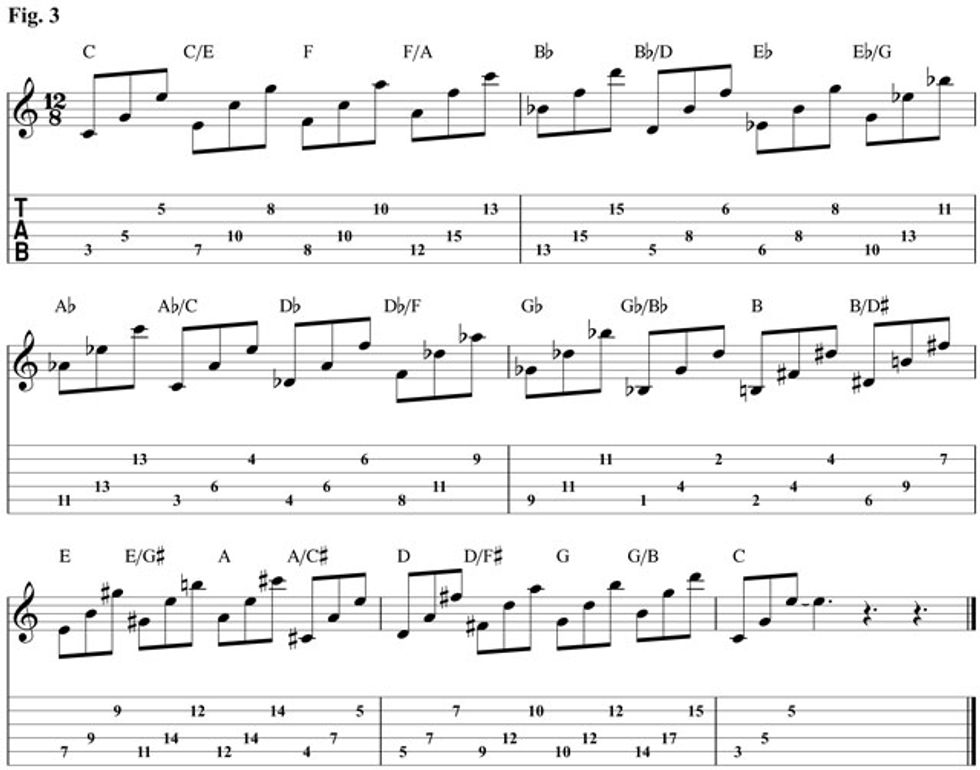Chops: Intermediate
Theory: Intermediate
Lesson Overview:
• Learn how to transform otherwise
boring exercises into
musical phrases.
• Understand how to apply
chords in unique combinations
across the neck.
• Slide linear scales across the
fretboard to open up the neck.
What do you think of when you hear the word “practice?” When I think of practice, I think of the following things: boring, repetitive, disciplined, structured, drills, metronomic, and scale patterns. I’ve been playing for the better part of 17 years now, and I have something to confess: I hate practicing. I really don’t enjoy it and every attempt at being structured or disciplined has always failed to motivate me in any way. I love getting better and improving my skills, but I hate what most of the world thinks of as practice. In this lesson, I want to talk about how I think about practicing and ways to keep it fun and creative, no matter what your level is.
Playtime
I absolutely love playing the guitar. I really
do cherish any time I can get with the
guitar in my hands. My love for the guitar
is what has allowed me to progress year
after year. So, how do you get better without
locking yourself in your room with a
metronome, vowing not to come out until
you’re a better guitarist?
Well, for one thing, you need to step back and think about how you’ve improved at other skills in your life. Carpenters don’t lock themselves in workshops working on saw technique. They get out and start building things. Sure, their first attempts are a little rough, but you get better by doing. If you want to get better at the guitar, you’d better play the guitar a lot. If you want to get better at something specific, you’re going to need to do it a lot. What I will push back on is the idea that you need to divorce technique and music from practice. It is possible to have fun, make music, and still improve. I just could never see how sitting in my room playing scale patterns with a metronome was going to help me get better when I’d never play scale patterns on stage like that. There has to be a better way, I thought.
Play Along. Play Often.
For whatever reason, I found playing guitar
by myself very lonely and boring. So
much so, that for the first four years of my
musical life, I only played along to CDs or
played with my band. Since the band only
practiced once a week, I spent the majority
of my musical life playing along to CDs. I
was ambitious, too. I played along to Steve
Vai, Yngwie Malmsteen, and Eric Johnson
CDs (and just about anything else I could
get my hands on). I really couldn’t play
most of their riffs, but what I was able to
do was play along in the same key. As I
was learning about scales and arpeggios, I
was able to apply them to real music right
away. I’m sure that if I listened back now,
I’d cringe at the epic noodling I was doing
back then, but at the time, it was a complete
blast. I was having fun.
I was also reinforcing my scales and arpeggios at the same time. I was tricking myself into practicing. And it worked. As time went on, I got more comfortable with the neck, I got more comfortable with my scales, I got more comfortable with arpeggios, and I was able to start figuring out the riffs, too. Because it was so much fun to play, I spent lots of hours doing it. Each hour that passed just continued to reinforce concepts that I needed. It was a wonderful cycle, and I can’t recommend it enough to anyone who wants to try something different, if traditional practice isn’t working for you. And, I had a better metronome than I could ever have wished for: a world-class drummer on each CD.
Enough philosophy, how about some examples?
When I play, I try to make it as fun and creative as possible, but I’m often thinking about something specific as a goal. For example, when I wanted to learn my arpeggios across the neck, I didn’t try to be a disciplined, responsible student and start small, learning arpeggio shapes in each position to combine them later. Nope. I wanted to sound like Yngwie or EJ right away. I set out to create some example riffs that took me across the fretboard, almost as if I were composing a riff for a guitar solo. Check out Fig. 1 for an example of what I’m talking about.

Since the example only consists of E, A, and B major triad arpeggios (I–IV–V in the key of E), I was able to play the example whenever I was playing in the key of E, and it always sounded good to me. In time, I moved the shapes around the neck and was able to learn more about arpeggios when the tracks I was playing along to changed keys.
Recently, I was thinking about different ways to play scales. After 17 years, even soloing with scale shapes can get a bit stale, so I looked at the neck and tried to come up with something different. I’ve played scales in positions, and in string groupings, but I’d never played them like in Fig. 2, sliding like a snake down the fretboard. This led me to think about composing riffs down the fretboard, rather than just sticking in vertical shapes all the time.

Finding examples like Fig. 2 was reinvigorating. What else could I do differently? I’ve always loved arpeggios and chords, but finding creative ways to play them is often difficult. Going back to my roots led me to Fig. 3, an Eric Johnson-style grouping of arpeggios that skip a string.

All I’m doing is playing major triads with a string skip immediately followed by the same arpeggio in the first inversion down the neck a few frets. Once the second shape is concluded, I start over one fret higher and keep going up the neck, dropping down 12 frets when I run out of room on my Tele. Now, you might be thinking, “That looks a whole lot like disciplined practice to me.” And you’d be right.
Once I played the exercise a few times to get the shapes down, I got bored because it keeps looping and changing keys in the cycle of fourths. It’s not that musical on its own, so I set out to make it more musical. Fig. 4 takes the same idea, locks it into a single key, and makes a riff out of it.

Fig. 4 takes the shapes of Fig. 3, adds the minor shape, and moves the patterns down one string a few times. It reminds me a little bit of Neil Zaza’s “I’m Alright,” which is another combination of spread arpeggios across the neck. By taking the example in Fig. 4 and playing it in a bunch of different keys, I’m getting the same benefit that Fig. 3 has, but I’m having more fun doing it, and it’s more creative. Heck, it even led to a song idea. That’s what practice is supposed to be about: inspiring your creativity and improving your skills.
As I’ve gotten older and my life has changed, it’s become even more important to use my time wisely when I play. Between family, writing, work, and making music, I don’t get as much time to play as I used to. When I do play, I make sure that I’m reinforcing the building blocks that enable me to make music, but I always focus on creativity. I hope this helps you think about practicing a bit differently, and helps you take an otherwise boring concept and make it work for you—especially if you don’t have a lot of time to play the guitar.
 Marc Schonbrun
graduated magna cum laude
from the Crane School of Music in New York.
He is an active educator, writer, and performer
in the San Francisco area, and has an eclectic
performing background that includes classical
concertos, jazz trios, and rock bands. An
active lecturer, Schonbrun frequently tours the
country explaining music technology to players
and teachers. Visit marcschonbrun.com
for more info.
Marc Schonbrun
graduated magna cum laude
from the Crane School of Music in New York.
He is an active educator, writer, and performer
in the San Francisco area, and has an eclectic
performing background that includes classical
concertos, jazz trios, and rock bands. An
active lecturer, Schonbrun frequently tours the
country explaining music technology to players
and teachers. Visit marcschonbrun.com
for more info.














